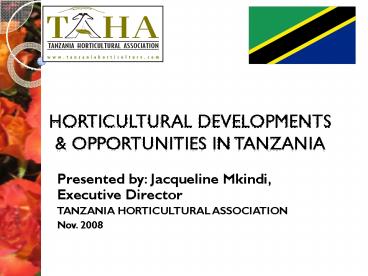HORTICULTURAL DEVELOPMENTS - PowerPoint PPT Presentation
1 / 16
Title:
HORTICULTURAL DEVELOPMENTS
Description:
Horticulture is regarded as having started in Tanzania in the 1950s ... Limes. Mangoes. Oranges. Passion Fruit. Pears. Pineapples. Raspberries. Strawberries ... – PowerPoint PPT presentation
Number of Views:53
Avg rating:3.0/5.0
Title: HORTICULTURAL DEVELOPMENTS
1
HORTICULTURAL DEVELOPMENTS OPPORTUNITIES IN
TANZANIA
- Presented by Jacqueline Mkindi, Executive
Director - TANZANIA HORTICULTURAL ASSOCIATION
- Nov. 2008
2
OVERVIEW
- TAHA
- BACKGROUND
- HORTICULTURAL PRODUCTS
- MAIN PRODUCTION AREAS
- MARKETS
- ACHIEVEMENTS/DEVELOPMENTS
- INVESTMENT OPPORTUNITIES
- WHY INVEST IN HORTICULTRE
- CONCLUSION
3
HORTICULTURE IN TANZANIA
- Horticulture is the fastest growing industry in
Tanzania - Export growth is 8 per annum
- Horticulture is regarded as having started in
Tanzania in the 1950s - Perishable horticulture for exports to Europe
started in the 1970s - The first cut flower farm was established in 1989
- Vegetables exports started in the 1970s but it
was only in 2000 when serious exports business
started.
4
Tanzania offers a wide range horticulture products
5
(No Transcript)
6
(No Transcript)
7
Major Horticultural Production Areas
- Northern highlands
- Flowers, cuttings, vegetables, fruits and seeds
Central plateau Tropical fruit and flowers
- Coastal Zone
- Citrus and tropical fruit
- Warm Southern Highlands
- Citrus and tropical fruit
- Cool Southern Highlands
- Flowers, cuttings, vegetables, fruits and seeds
8
(No Transcript)
9
MAIN MARKETS
- Main market is Europe
- 75 - 80 of fresh flowers goes to the auctions
in Holland - Other markets in Europe include Norway, Germany
and the UK - The members are trying to venture into other
markets e.g. USA, Japan and the Middle East - Members also sell to the countries in the EAC and
SADC as their regional markets
10
EXPORT TREND
11
DEVELOPMENTS
- Effective coordination in the sector
- Donors Intervention- The Dutch Government, USAID,
BEST- AC, etc - Government Support- i.e HODECT
- Links to service providers
- Promotion and awareness Creation Programmes
- More investments
- Increased productivity and exports
- Market diversification
12
Developments cont..
- Capacity Building
- Technical Training Programmes
- Financial support- TIB BOT, Credit guarantee
scheme for small holder farmers - Increased participation by small holder farmers
13
Horticultural Investment Opportunities
- Air freight operators
- Manufacturing of raw materials (packaging
materials, agro inputs, driplines, planting
troughs, etc) - High value vegetable exporting
- Processing and canning of fruits
- Flower farming
- Laboratory-testing and analysis
14
WHY INVEST IN TZ. HORTICULTURAL SECTOR
- Favorable climate- from tropical to temperate
climate - Wide network of rivers and lakes
- Underutilized arable land
- Competitive labor costs
- Political stability and peaceful people of
Tanzania - Existence of a vibrant Association
- TIC- one stop shop for investment guide.
15
CONCLUSION
- If you are yet to make a right decision in your
life, do it now, invest in the horticultural
industry in Tanzania, and you will never regret!!!
16
- Tanzania Horticultural Association
- P .O. Box 3003
- ARUSHA, Tanzania
- Tel 255 27 2544568
- Fax 255 27 254 4568
- Emailtaha_at_habari.co.tz
- WWW.tanzaniahorticulture.com































